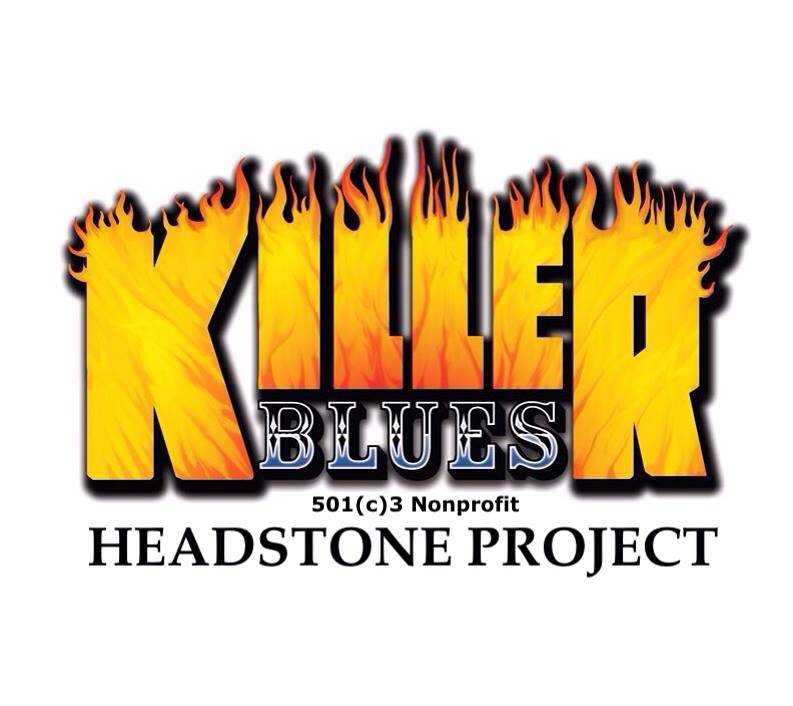
It was 1997 when Steve Salter, the owner of a CD distribution business called Killer Blues, traveled to the New Orleans Jazz and Heritage Festival from his home in Whitehall, Michigan. Along the way, he decided to stop and pay his respects to Blues artists that he never got to see in person. Folks like Muddy Waters, Howlin’ Wolf and Otis Spann were all buried in the Chicago area, so that’s where Salter went first.
When he arrived at the Restvale Cemetery, he was surprised at the size of Waters’ headstone. A one-foot by two-foot by four-inch stone marked the grave of the “High King of Blues”. Continuing on to the Burr Oak Cemetery, he was even more shocked to realize that the great Otis Spann had been lying in an unmarked grave for nearly 30 years. It was then and there that Salter made the decision that something had to be done and the idea of the Killer Blues Headstone Project was born.
He first wrote a letter to Blues Revue magazine to say, “This piano great is lying in an unmarked grave. Let’s do something about this deplorable situation”. Blues enthusiasts from around the world sent donations to purchase Spann a headstone. On June 6th, 1999 the marker was unveiled during a private ceremony. The stone reads “Otis played the deepest blues we ever heard – He’ll play forever in our hearts”.
Salter came up with the “Buried in the Blues” Calendar and spent several years researching and putting it altogether before finally going to print in 2008. No other calendar was available that listed over 1,000 birth and death dates of blues artists. Also, in 2008, Salter put on the first White Lake Blues Festival in his hometown of Whitehall, Michigan to bring awareness to his cause and to raise more money for headstones. The festival was a success and the first headstone for Major “Big Maceo” Merriweather was placed.
It was around this time that another Blues lover, Aaron Pritchard from St. Louis, Missouri was on the Killer Blues website and contacted Salter via email with information on where a couple of the graves Salter was looking for were located. This began a friendship and working relationship that lasts to this day, with Pritchard being the current Vice-President of the organization.
Both men have a passion for visiting the grave sites of deceased Blues performers to pay their respects, and, where needed, supplying headstones for those graves that are unmarked. They are undaunted cultural historians, musicologists, archivists and detectives.
In 2009, The Killer Blues Headstone Project became a 501(c)3 nonprofit organization. It remains that way today, with every dime going toward the purchase and placement of headstones. The current Board of Directors, five in all, do not draw any type of salary from funds collected. They are all about preserving the legacy of the deceased artists and their contributions to music. In the early years, they placed one or two headstones per year.
One of their most remembered unveilings was that of the headstone of Eddie King in Peoria, Illinios, where thirty or more family members showed up. Pritchard recalls, “It was one of the most touching, humbling experiences of my entire life. Something that I’ll never forget”.
The headstones that the organization purchases are one-foot by two-foot by four-inches; the exact size of the stone at Muddy Waters’ grave. The stones cost $300 to $400 each to be carved and each is specific to the artist. The stones all have the name, birth and death dates, but then most contain either a graphic relating to the instrument the person played, or a quote from that particular artist, or both. The Project works closely with the families of the deceased to insure that the headstones are to their liking and meet with their approval.
The organization has placed 32 headstones to date, averaging 12 per year currently, and have contributed to 9 others. The cost of placing the stones varies on the location of the cemetery. Some are older, non-maintained sites that usually don’t charge for placement, while others may charge $1,000 or more for headstones to be placed. Killer Blues have placed markers from Michigan through a “Blues corridor” to the Delta in Mississippi and as far away as California.
The only “non performer” who has received a headstone was “Stagger” Lee Shelton (“Stagolee”, “Stagger Lee”, “Stack-O-Lee”), the St. Louis pimp infamous for killing Billy Lyons on Christmas Day, 1895 in a dispute over Shelton’s Stetson hat. That incident has been immortalized in Blues and Folk songs thousands of times since 1897 and has been recorded by everyone from “Professor” Charlie Lee (The Kansas City Piano Thumper) to Nick Cave & The Bad Seeds. Shelton died in the Missouri State Penitentiary in Jefferson City and is buried at the historic Greenwood Cemetery in Hillsdale, Missouri. Pritchard says, “The story of Stagger Lee has contributed as much to the Blues as any other story I can think of”.
The Killer Blues Headstone Project depends on donations to keep their work ongoing. Blues festivals in Whitehall, Michigan and St. Louis, Missouri; the sale of t-shirts, calendars and original art, as well as donations online have the Project headed for a goal of 40 stones to be placed by the end of 2014; 5 of which are currently in production.
The website, www.killerblues.com also has a list of over a dozen musicians whose burial sites are unknown and over 30 who are known to lay in unmarked graves.

